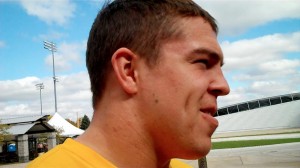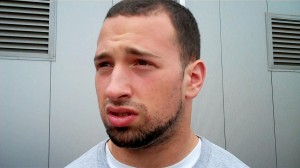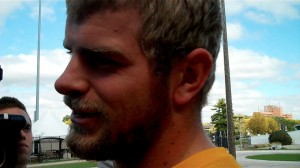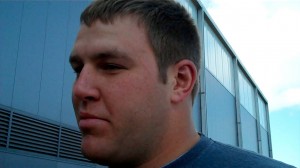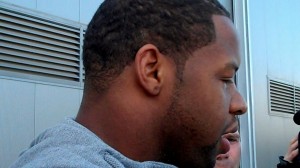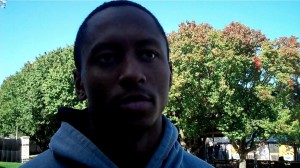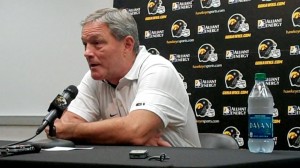
Iowa head coach Kirk Ferentz discusses the Hawkeyes’ bye week during a press conference featuring both his coordinators held Tuesday, Oct. 8, 2013, at the Hayden Fry Football Complex in Iowa City.
By Brendan Stiles
HawkeyeDrive.com
IOWA CITY, Iowa — Much like 2012, the Iowa Hawkeyes sit at the halfway point of their season with a 4-2 overall record. Much like 2012, they face a challenging back-half of their schedule, which this year features three Big Ten teams currently ranked — including Iowa’s upcoming opponent in No. 4 Ohio State — and two others barely sitting outside the AP top 25 entering this weekend’s slate of games.
But unlike last year, one that saw the Hawkeyes lose their final six contests and finish 4-8, Iowa head coach Kirk Ferentz showed no hesitation Tuesday afternoon expressing belief in the current make-up of his team.
“I think all of us feel this is a better football team,” Ferentz said. “We’re a more capable team right now. But every year is a new adventure, every game is a new adventure.
“But we like the football team. I think we’re on the right path right now.”
With Iowa going through the first of two bye weeks it will have this season, Tuesday presented both Ferentz and both of his coordinators an opportunity to take the dais inside the Hayden Fry Football Complex and reflect on what offensive coordinator Greg Davis said was a chance to “look in the mirror” at where the Hawkeyes are and how they can avoid a repeat of 2012.
In determining an offensive identity, Davis said the biggest thing is finding balance. Through six games, Iowa has a run-pass ratio of approximately 61-39.
“We’re not a team that’s built to throw it 50 and run it 30,” Davis said. “We want to be a balanced team because we can protect better. We’ve done much better this year protecting the quarterback.”
Defensively, the Hawkeyes are currently ranked 11th nationally in total defense, giving up an average of 290 yards per game to opponents. Iowa has also only given up 24 third-down conversions out of 90 it has forced so far. Given the statistical track his defense is currently on pace for, defensive coordinator Phil Parker said he feels good knowing the number of big plays would be below what they were a year ago.
“I feel good about the group, how close they are, the chemistry. I think we have more depth,” Parker said. “I think there are more guys that are capable to go on the field and perform at a high level to win.”
Iowa plays four games between bye weeks, with three of them coming against teams Ferentz and his staff aren’t entirely familiar with. One of those three teams is the Hawkeyes’ next opponent — Ohio State. Iowa’s last meeting with the Buckeyes came in 2010 and the only other encounter Ferentz has had with current Ohio State coach Urban Meyer came in the 2006 Outback Bowl when Meyer coached Florida.
Ferentz said time would be spent by him and his staff studying the Buckeyes and that he hoped to present a game plan to his players on Sunday, which would be two days earlier than a normal game week where Iowa isn’t coming off a bye.
“We don’t want to do too much too soon,” Ferentz said. “But as a coaching staff, we have the chance to get a lot of work done this week and what we’re going to try and do is take advantage of that time.”

Iowa offensive coordinator Greg Davis discusses the Hawkeye offense during his press conference held Tuesday, Oct. 8, 2013, at the Hayden Fry Football Complex in Iowa City.
Assessing the offense
The biggest takeaway with the Hawkeye offense is how the number of plays has correlated with success. In Iowa’s four victories this season, the Hawkeyes are averaging around 80 plays per game and they currently lead the Big Ten in offensive snaps per game after finishing last in the conference in that same category a year ago.
In Iowa’s 26-14 loss last weekend to Michigan State, the Hawkeyes were only able to put together 62 offensive snaps, easily the lowest number in a game this season. When Iowa did have success moving the ball on the Spartans’ defense however, it came on a pair of second-quarter possessions where the tempo accelerated from what it was and then went back to being in the second half.
Going forward, Davis said he doesn’t foresee Iowa becoming strictly up-tempo during these final six regular season games like it appeared the Hawkeyes might be entering this season given the amount of no-huddle used during offseason practices.
“It’s something that we’ll continue to do, but we’re not going to become just a team that runs to the line and tries to snap it,” Davis said. “We do want to play fast, faster than we have. I think we have done that. But each ball game will be a little bit different about how we approach it.”
The pace might not become quicker, but the element of speed could become more prominent. While Davis said there isn’t a “magic number” of snaps he would ideally like to have junior college transfer Damond Powell involved in, the number of snaps Powell gets going forward should increase given his comfortability with how Iowa operates offensively.
“It has been a process. Obviously, we didn’t have to teach him how to run fast. He brought that with him,” Davis said. “But we want to continue to bring him on because he is a guy that can do things with it after the catch.
“We are aware that he’s a guy that we have to keep bringing on. There’s no question.”
As for the ground game, Davis and Ferentz both reiterated the value that both running backs Mark Weisman and Damon Bullock bring to the offense, which is why both of them (when healthy) are expected to remain heavy contributors going forward. Davis brought up improvements made by Bullock over the last couple of games with both blitz pick-ups and vision, which he credited to playing a role on his 47-yard touchdown reception last weekend.
“I think earlier in the year, he was looking for some home runs and not following his block,” Davis said. “Mark brings a certain thing and I think Damon brings something that’s a little bit different and we need both of those guys functioning at a high level to be able to get what we want out of them.”

Iowa defensive coordinator Phil Parker discusses the Hawkeye defense during his press conference held Tuesday, Oct. 8, 2013, at the Hayden Fry Football Complex in Iowa City.
Assessing the defense
One striking observation from Parker’s time speaking Tuesday afternoon was the analytics he mentioned. Parker specifically made mention of how Iowa has blitzed around 15 percent of the time (59 times out of 394 snaps) and how 73 percent of those 59 blitzes have proven effective for the Hawkeyes thus far.
Parker also shared his thought process on when he opts to use nickel packages on third down plays versus staying in the base 4-3 look Iowa uses. He said a lot of it depends on distance, the number of yards an opposing offense needs to move to chains.
The trade-off when Iowa does use nickel is an extra defensive back — which so far this season has been sophomore cornerback Sean Draper — comes in the game for senior linebacker Anthony Hitchens, who currently leads the Hawkeyes with 59 tackles through six games. Hitchens’ play thus far has forced Parker to give more thought to whether he wants to take him out whenever Iowa forces a 3rd-and-long.
“He plays full go all the time in practice,” Parker said. “Last year, he had a lot of tackles. This year, I think he just understands where the play is going and see its faster and he’s full go.”
As far as the defensive line is concerned, Parker said he was pleased with what he has seen with the current 7-man rotation Iowa has taking place along the front four. The non-starters part of that rotation include junior defensive end Mike Hardy (who saw more snaps than usual against Michigan State due to Dominic Alvis leaving the game with an undisclosed injury) and sophomore defensive tackle Darian Cooper, who Parker said is essentially a fifth starter. It also features Nate Meier at defensive end in third-down situations where the Hawkeyes go to their nickel package.
Then there’s the group with the biggest question mark — the secondary. It’s a group that has drawn the most criticism due to opposing offenses being able to convert big passing plays for scores, with the most recent being a pair of touchdown passes from Michigan State last weekend that were both over 35 yards each.
Parker said a lot of the issues have to do with fundamental technique and he stresses the importance of having a memory bank to his defensive backs so they know what mistakes not to continue making.
“You’re on an island, everybody sees it,” Parker said. “There’s a lot of guys up front making mistakes that nobody knows about. But once you give up one back there, everybody knows about it.
“You’ve got to have a good memory. You got to have a good file cabinet and remember the things that you need to remember and be able to pull them up of splits and alignments and the formations and then you’ve got to be able to have a short memory when things go bad for you. You’ve got to be able to drop it and go to the next play.”
Assessing special teams play
For someone who in years past has shown restraint from speaking publicly during his team’s bye weeks, Ferentz faced the media Tuesday and briefly took questions before letting his coordinators share their insights.
As one might imagine, the topic of special teams was discussed in light of last weekend’s 26-14 loss to Michigan State, in large part because the Spartans pulled off a fake punt where punter Mike Sadler ran for 25 yards (more yards than Iowa had on the ground total) into Hawkeye territory. The play ultimately led to Michigan State field goal that made it a two-possession game with the Spartans extending their lead to 23-14.
Iowa’s return unit on the field for that fake punt consisted of wide receiver Riley McCarron filling in for an injured Kevonte Martin-Manley as the return man and then the following blockers: receivers Jordan Cotton and Jacob Hillyer, tight end George Kittle, fullback Macon Plewa, linebackers Travis Perry, Cole Fisher and Quinton Alston, and defensive backs Maurice Fleming, Nico Law and Gavin Smith.
To put this into perspective, none of those 11 players were on the field for the other fake punt Iowa gave up this season to Northern Illinois, which occurred with the Hawkeyes lined up in “punt safe” with their starting defense sans free safety Tanner Miller, who came out for that play to allow Martin-Manley to line up as the return man.
Following the game, Ferentz made a comment about he might consider not having a return set up ever again. He reiterated the thought again Tuesday afternoon, adding that he wasn’t being facetious about it.
“When you do that, to block guys, you have to turn and go with those guys just to shadow them,” Ferentz said. “When you do that, you open the door. Michigan State did a good job of taking advantage of that, to their credit.”
In the last 44 games dating back to 2010, Iowa has surrendered four successful fake punts (including the one last weekend), two successful fake field goal attempts (both of which happened in 2011) and four onside kicks — all of which occurred in separate games each of the past four seasons. The Hawkeyes’ record in these games where opponents have successfully executed a special teams gimmick is 2-8, with the two wins being this year’s 27-21 victories over Iowa State (the most recent onside kick) and the 2010 season opener against Eastern Illinois (the first fake punt).
Despite all of that however, Ferentz believes the entire body of work thus far in 2013 has shown Iowa making progress in football’s third phase and that there isn’t any sort of over-thinking taking place as players continue to fit in the schemes installed by first-year assistant coach Chris White.
“We’re going the right direction,” Ferentz said. “We went backwards the other day on that phase. But again, I’m judging six weeks and I think there’s room for improvement there. I think we have reason to be optimistic.”
TRANSCRIPTS (courtesy of UI Sports Info.): Kirk Ferentz/Greg Davis/Phil Parker (10/8/2013)

